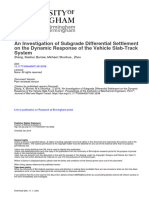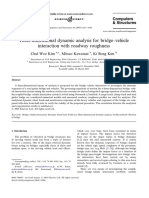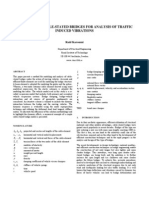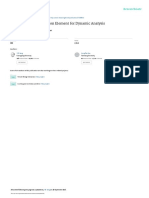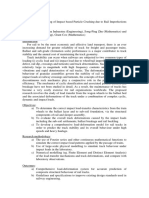Vehiclestructure Dynamic Part1
Vehiclestructure Dynamic Part1
Uploaded by
dbhawal6388Copyright:
Available Formats
Vehiclestructure Dynamic Part1
Vehiclestructure Dynamic Part1
Uploaded by
dbhawal6388Original Description:
Copyright
Available Formats
Share this document
Did you find this document useful?
Is this content inappropriate?
Copyright:
Available Formats
Vehiclestructure Dynamic Part1
Vehiclestructure Dynamic Part1
Uploaded by
dbhawal6388Copyright:
Available Formats
Dynamic Loading
for High Speed Railways
Dipankar Bhawal **
ABSTRACT
Dynamic amplification and related phenomena of bridges due to loads from vehicles moving at different speed
should be studied in light of increased capacity of these to run at higher speed and volume. In India the intricate
network of the highways and the railways play an important role in safely carrying freight and passengers in bulk.
These networks consist of several small and long span cross drainage structures , culverts , bridges etc. They should
be made safe, operable and should be regularly upgraded on the basis of nature, frequency and economic importance
of the traffic. Some sections of this network, specially bridges or viaducts may require reassessment in terms of their
performance when subjected to heavy traffic and also when falls in the route which is dedicated as say high-speed
railway corridors. Current provisions of code for bridges may require some enhancement in terms of modified
impact factors or dynamic augmentation factors for live loads like high speed railway-trains or similar vehicles.
These dynamic impact factors shall be ascertained in light of vehicle-structure interaction between dynamic-moving
vehicles and the structures during design of both new as well as during inspection of old bridges. Also there is a
need for adopting generalised high speed load models representing a range of moving loads which becomes
necessary from the point of view interoperability of different types of high speed railway cars or general vehicles
meant for roadways. As a specific case railway bridges are chosen to be the ideal structures for this study.
Keywords : Vehicle-structure Dynamic Interaction, Dynamic Impact factor, High Speed Load Models.
1. INTRODUCTION
There is a strong urge for improvement some cases the increment in response (after
in the field of transportation in India which is applying CDA) of superstructures for bridges
reflected in expansion of road networks and with shorter spans is higher and conservative for
introduction of High-Speed Railway systems a certain range of speed. Traditional code based
into existing railway network. This move approaches can result in underestimation of
undoubtedly indicates an aspiring and growing responses of bridges under dynamic action
economy of our nation. However this caused by high-speed trains(HST). Therefore
development also demands improvement and some additional analysis is needed for bridges
reassessment of strength and safety of both when subjected to dynamic loading by railway-
existing and future infrastructure like tracks and cars moving at high speed. Extensive
inter-linking bridges. experimentation on the problem of dynamic
Our existing codes for bridges amplification of superstructures of bridges due
(railways) takes into account of increase in to moving vehicles have already been carried out
dynamic response of superstructures of bridges by various authorities. This study is an attempt
due to railway-cars by deriving impact factors to point out the need to review the prevalent
from specific formulae (coefficient of dynamic approaches in this respect and streamline them
augment-CDA) meant for railway tracks of as code provisions or recommendations.
different gauges and numbers [1] .This code
based formula serves well for a majority of the 2. OBJECTIVE OF THIS STUDY
super-structures if the speed of vehicles and
length of the span of superstructures is restrained The necessity of carrying additional
within specific range. Also it can be seen that for analysis of superstructures by taking into
** Chief Consultant-Newline Consulting Engineers, India , BE, M-Tech(Structures) ; e-mail:
dbhawalnce@gmail.com 1
account of vehicle-structure interaction can be specially in preliminary investigations. In this
justified by comparing the impact factors study superstructures are idealised as one single
derived by three different methods. One of beam element with flexural rigidity having
which is the direct approach such as by using the pinned supports as boundaries, consisting of
traditional code-based formula (CDA), one by uniformly distributed mass and constrained to
applying the static loads at various positions respond vertically only. Also the beam element
with time without considering vehicle-structure is assumed to have negligible shear deformation
interaction and the third one is derived by and rotational rigidity. The rotational inertia of
considering vehicle-structure interaction the rigid vehicle bodies will be ignored.
analysis. Also it can be shown that general Dynamic loads from railway-cars shall be
models developed on the basis of applied in the form of point loads from
interoperability of various commercial railway- corresponding point masses, being transferred
vehicles can simplify the process of design and through axle/wheel-sets(combined in pairs) as
inspection of bridges on various stretches. For shown in schematic figures (Fig. 1 and Fig.
this purpose response of two types of different 2).These point masses will be supported by
spans of ballast less steel bridges having single representative springs and dampers and will be
track running along the bridge axis with a span termed as primary and secondary suspension
length of 20.0 m and the other with 80.0 m are elements. Mass of the wheel-axles will be un-
chosen and assumed to be carrying rolling stocks sprung; mass of the bogie frame and the rail-cars
traversing at different speeds. Only critical will be sprung and dampened with mechanical
results shall be presented for this study. springs and dampers. Mechanical spring
constants and damping coefficients assumed
3. DESCRIPTION OF MODELS here are the average values and representative of
a certain range of constants Table.1 [4], which
In most of the cases the responses of may vary from one project to another. These
simply supported superstructures of bridges will values are equally distributed among the axle
be found to be critical. Although this verification points. Detailed analysis with enhanced models
should also be carried out on continuous may be required to simulate the interactions
structures, for simplification simply supported between various interface elements e.g. rail-car
(isostatic) structures are selected. To take into and track, track and ballast, ballast and deck etc.
account of different types of trains as an which can be formulated by assuming additional
example, informative loads from the set of elements representing tracks, rail-pads, sleepers
models called HSLM-A (A1 to A10) from UIC- and ballasts respectively. The effect of
Code Leaflet, 776-2,Appendix -B, Table. 6 [2] irregularities of tracks, spacing of sleepers,
will be used for these verifications. In practice flatness of wheels, loss of contact of wheels etc.
these models shall be changed to make suitable could also be introduced as numerical models.
as per requirement and applicability of the For this study the effect of these parameters will
railways. Spatial models with MDOF both for be ignored which may not always be required
the bridge and the vehicles could be adopted for for bridge designers but for the study or design
in depth analysis of such systems but simplified of the rail-vehicles for safety, efficiency and
models with SDOF (for both bridge and vehicle) comfort of the passengers.
are sufficient for majority of the cases and
** Chief Consultant-Newline Consulting Engineers, India , BE, M-Tech(Structures) ; e-mail:
dbhawalnce@gmail.com 2
Fig. 1 : Schematic configuration of Models of Universal Dynamic-Train : HSLM-A, [2]
Fig. 2 : Idealised model of a single car and components , load from wheel-axles and beam element
4. NUMERICAL BASIS OF THE where mode shape is assumed for maximum
ANALYSIS 𝑛𝑛 𝜋𝜋 𝑥𝑥
amplitude Φn (𝑥𝑥) = 1 × 𝑠𝑠𝑠𝑠𝑠𝑠 ( 𝐿𝐿
) subject to the
The dynamic behaviour of the beam
element can be mathematically expressed on the condition as
basis of a forced dynamic analysis derived from {Φ(𝑥𝑥)}
the traditional beam theory (Chapter-16) [3].
Φ(𝑥𝑥) , 𝑖𝑖𝑖𝑖 𝑥𝑥 < 𝐿𝐿 𝑎𝑎𝑎𝑎𝑎𝑎 𝑥𝑥 > 0
Though finite elements can be used for =� else
improved and finer analysis, modal analysis of a 0
isostatic beam element, which can represent both
and for kth. axle relative displacement 𝑥𝑥𝑟𝑟𝑘𝑘 = (v ×
girder type as well as truss bridges when
t - 𝑥𝑥𝑜𝑜 )k where 'v' (kmph) is the velocity of the
vibrating in their lowest modes is sufficient for
axles and say {𝑥𝑥𝑜𝑜 } is the distance of the starting
this study. Following analysis will be carried out
points of different axles from left support;
assuming that there is no geometric- nonlinearity
Therefore for nth. mode 𝑀𝑀𝑛𝑛 = modal mass, 𝐶𝐶𝑛𝑛 =
and both material as well as additional spring or
2 ξ 𝑀𝑀𝑛𝑛 𝜔𝜔𝑛𝑛 ; ξ = critical damping ratio as per
damping elements should also behave linearly.
𝑛𝑛 2 𝜋𝜋 2 𝐸𝐸𝑠𝑠𝑠𝑠 𝐼𝐼
For nth. mode of vibration of uniform (A.3.2,Table.2 [2] ) ; Frequency 𝜔𝜔𝑛𝑛 = �
𝐿𝐿2 𝜇𝜇
beam element of span length with distributed
; Est I = flexural rigidity of the beam (or
mass of μ kN/m (assumed to be the sum of dead
equivalent of a truss type bridge obtained from
load from self weight and super imposed loads
previous design of bridges meant for Broad
like tracks, sleepers, fixtures railings etc.) the
Gauge (BG) Loadings) ; Modulus of elasticity of
equilibrium condition of the modal mass 𝑀𝑀𝑛𝑛 at
steel Est = 2.0 ×108 kN/m2 ; 𝐹𝐹𝑘𝑘𝑠𝑠𝑠𝑠𝑠𝑠𝑠𝑠𝑠𝑠𝑠𝑠 (t) = Static
time t when loading on the beam at location 'x'
force at time t due to axle loads 𝑃𝑃𝑘𝑘 (𝑡𝑡) =
from left support (x = 0 )can be expressed as,
𝑚𝑚𝑘𝑘 (𝑡𝑡)𝑔𝑔 = (𝑚𝑚𝑤𝑤 (𝑡𝑡) + 𝑚𝑚𝑏𝑏 (𝑡𝑡) + 𝑚𝑚𝑐𝑐 (𝑡𝑡)) ×
𝑀𝑀𝑛𝑛 𝑞𝑞̈ + 𝐶𝐶𝑛𝑛 𝑞𝑞̇ + 𝐾𝐾𝑛𝑛 𝑞𝑞 =
𝑔𝑔 (𝑚𝑚/𝑠𝑠 2 ) where (masses in kg) mw = mass of
∑𝑘𝑘 �Φn �𝑥𝑥𝑟𝑟𝑘𝑘 ��(𝐹𝐹𝑘𝑘𝑠𝑠𝑠𝑠𝑠𝑠𝑠𝑠𝑠𝑠𝑠𝑠 (𝑡𝑡) + 𝐹𝐹𝑘𝑘𝑑𝑑𝑑𝑑𝑑𝑑𝑑𝑑𝑑𝑑𝑑𝑑𝑑𝑑 (𝑡𝑡)) ..(𝐸𝐸1) wheel and axle, mb = mass from bogie and mc =
** Chief Consultant-Newline Consulting Engineers, India , BE, M-Tech(Structures) ; e-mail:
dbhawalnce@gmail.com 3
You might also like
- Mass On A Spring Interactive Purpose:: From The Physics Classroom's Physics InteractivesDocument4 pagesMass On A Spring Interactive Purpose:: From The Physics Classroom's Physics InteractivesEarl Mathew DangcalanNo ratings yet
- Lesson Plan About SoundDocument4 pagesLesson Plan About SoundAzia Faustino73% (11)
- Wheel Load Contact AreaDocument13 pagesWheel Load Contact AreaGnabBang100% (1)
- Twin Flames Finding Forever Love Starter Kit Edited1.2 PDFDocument28 pagesTwin Flames Finding Forever Love Starter Kit Edited1.2 PDFmargaritosaNo ratings yet
- Aerodynamic Balance & Flight Control Balancing and RiggingDocument11 pagesAerodynamic Balance & Flight Control Balancing and Rigginghuzaifah_zainudin63% (8)
- Biondi Et Al 2005Document11 pagesBiondi Et Al 2005Saymo Wendel de Jesus Peixoto VianaNo ratings yet
- Vehiclestructure Dynamic 14112016 Part3Document1 pageVehiclestructure Dynamic 14112016 Part3DipNo ratings yet
- 1 s2.0 S0141029622010331 MainDocument19 pages1 s2.0 S0141029622010331 Main100NadaNo ratings yet
- IJCE v8n1p44 enDocument13 pagesIJCE v8n1p44 enshubham jainNo ratings yet
- iNEW Method For Experimental-Numerical Locomotive Studies Focused On Rail Wear PredictionDocument15 pagesiNEW Method For Experimental-Numerical Locomotive Studies Focused On Rail Wear PredictionQing WuNo ratings yet
- Train Trajectory Optimisation of ATO Systems For Metro LinesDocument6 pagesTrain Trajectory Optimisation of ATO Systems For Metro LinesOsa OlabyNo ratings yet
- Rsi On Integrated Double Decker BridgeDocument11 pagesRsi On Integrated Double Decker BridgeMahavir KishorNo ratings yet
- Sebastian 2018Document11 pagesSebastian 2018Saymo Wendel de Jesus Peixoto VianaNo ratings yet
- State Dependent Properties of Rail Pads: Research OnlineDocument9 pagesState Dependent Properties of Rail Pads: Research OnlineSantha Raman R RNo ratings yet
- Track Structure Interaction Analysis Using FE Techniques Lusas ArchiveDocument8 pagesTrack Structure Interaction Analysis Using FE Techniques Lusas ArchiveMURTHYNo ratings yet
- Engineering Structures: Mahir Ülker-Kaustell, Raid Karoumi, Costin PacosteDocument7 pagesEngineering Structures: Mahir Ülker-Kaustell, Raid Karoumi, Costin PacosteBRAYAN GERARDO AREVALO MENDOZANo ratings yet
- Simultaneous Estimation of Wheel-Rail Adhesion and Brake Friction BehaviourDocument6 pagesSimultaneous Estimation of Wheel-Rail Adhesion and Brake Friction BehaviourManjunath AithalNo ratings yet
- Simulation of Vertical Dynamic Vehicle-Track InterDocument26 pagesSimulation of Vertical Dynamic Vehicle-Track InterBARIŞ KalyonNo ratings yet
- Estimation of The Strength Capacity of Existing Concrete Bridges in RomaniaDocument7 pagesEstimation of The Strength Capacity of Existing Concrete Bridges in RomaniaIonutRacanelNo ratings yet
- 5wacmge ArtigoDocument14 pages5wacmge ArtigoRajshri sumanNo ratings yet
- State Dependent Properties of Rail Pads: Research OnlineDocument9 pagesState Dependent Properties of Rail Pads: Research OnlineMaркo ДеурићNo ratings yet
- Study of Integral Structure Behaviour For Rail Structure Interaction in The Proposed Metro ViaductDocument7 pagesStudy of Integral Structure Behaviour For Rail Structure Interaction in The Proposed Metro ViaductAjay MahawerNo ratings yet
- Dynamic Response of Vehicle and Track in Long Downhill Section of High-Speed Railway Under Braking ConditionDocument15 pagesDynamic Response of Vehicle and Track in Long Downhill Section of High-Speed Railway Under Braking ConditionYan SunNo ratings yet
- Applsci 13 12455Document28 pagesApplsci 13 12455lilyuri163No ratings yet
- The Importance of Sleepers Spacing in RailwaysDocument15 pagesThe Importance of Sleepers Spacing in RailwaysPatrick Macedo100% (1)
- An Investigation of Subgrade Differential Settlement On The Dynamic Response of The Vehicle Slab Track SystemDocument26 pagesAn Investigation of Subgrade Differential Settlement On The Dynamic Response of The Vehicle Slab Track SystemAndrew OwenNo ratings yet
- Power System Modelling For Urban Massive Transportation SystemsDocument25 pagesPower System Modelling For Urban Massive Transportation SystemsdeivaNo ratings yet
- Econonmic Analysis in The Optimization of Belt Conveyor SystemsDocument22 pagesEcononmic Analysis in The Optimization of Belt Conveyor SystemsTimber RamNo ratings yet
- Novel Method of Estimation of Inertial and Dissipative Parameters of A Railway Pantograph ModelDocument24 pagesNovel Method of Estimation of Inertial and Dissipative Parameters of A Railway Pantograph Modelnikunjsingh04No ratings yet
- Marques 2018Document24 pagesMarques 2018shivamani peddiNo ratings yet
- LiteratureDocument22 pagesLiteratureSHRADDHA KADAMNo ratings yet
- Soil Dynamics and Earthquake Engineering: SciencedirectDocument7 pagesSoil Dynamics and Earthquake Engineering: Sciencedirectiuli21No ratings yet
- Calculation of Dynamic Amplification Factor For Railway Concrete and Masonry Arch Bridge Subjected To High Speed TrainsDocument15 pagesCalculation of Dynamic Amplification Factor For Railway Concrete and Masonry Arch Bridge Subjected To High Speed TrainsRaviJangidNo ratings yet
- Kim 2005Document19 pagesKim 2005Giulio PalamàNo ratings yet
- Ballastless TrackDocument13 pagesBallastless TrackshahzilezNo ratings yet
- Cross: Mechanical Systems and Signal ProcessingDocument18 pagesCross: Mechanical Systems and Signal ProcessingMohammed TouatiNo ratings yet
- Assessment of Railway Plain Concrete Arch Bridges Subjected To High Speed TrainsDocument20 pagesAssessment of Railway Plain Concrete Arch Bridges Subjected To High Speed TrainsMahavir KishorNo ratings yet
- Evaluation of Longitudinal Force On A RaDocument13 pagesEvaluation of Longitudinal Force On A RaMilchoNo ratings yet
- Cable Stay Bridge ModellingDocument7 pagesCable Stay Bridge ModellingVivek PremjiNo ratings yet
- Bryja 2011Document11 pagesBryja 2011Jarvis BlueNo ratings yet
- Dynamic Responses of Train-Track System To Single Rail IrregularityDocument16 pagesDynamic Responses of Train-Track System To Single Rail IrregularityGAUTAM DUANo ratings yet
- Analytic Method For Vibration Analysis of Trackstructure Induced by High Speed TrainDocument12 pagesAnalytic Method For Vibration Analysis of Trackstructure Induced by High Speed TrainMaria Rafaela Bezerra de Macêdo RibeiroNo ratings yet
- Study of The Influence of Geometrical and Mechanical Parameters On BallastedDocument8 pagesStudy of The Influence of Geometrical and Mechanical Parameters On Ballastedala younesNo ratings yet
- 1997 VBIASCEYauDocument8 pages1997 VBIASCEYauMücahit AtalanNo ratings yet
- Research Article: Stochastic Analysis On The Resonance of Railway Trains Moving Over A Series of Simply Supported BridgesDocument15 pagesResearch Article: Stochastic Analysis On The Resonance of Railway Trains Moving Over A Series of Simply Supported BridgesRiddhiman bhowmikNo ratings yet
- Finding The Train Composition Causing Greatest Fatigue Dama - 2019 - EngineeringDocument13 pagesFinding The Train Composition Causing Greatest Fatigue Dama - 2019 - EngineeringeliNo ratings yet
- Goicolea LasPalmas CompleteDocument31 pagesGoicolea LasPalmas CompleteAbdulrahman AfabafalNo ratings yet
- Measurement: Liang Gao, Bolun An, Tao Xin, Ji Wang, Pu WangDocument14 pagesMeasurement: Liang Gao, Bolun An, Tao Xin, Ji Wang, Pu WangshahzilezNo ratings yet
- Dynamics of Bridges During Proof Load Tests and Determination ofDocument15 pagesDynamics of Bridges During Proof Load Tests and Determination oflucasssbotelhoNo ratings yet
- Vibration 04 00013 PDFDocument24 pagesVibration 04 00013 PDFRat Jaga CivilNo ratings yet
- Considerations On Longitudinal Dynamic Effects ofDocument17 pagesConsiderations On Longitudinal Dynamic Effects ofAdrian StroeNo ratings yet
- Updated 1Document12 pagesUpdated 1MAAZ KHANNo ratings yet
- GVFHSR 63792 187Document30 pagesGVFHSR 63792 187Mücahit AtalanNo ratings yet
- Forecast of Electric Vehicle Charging Demand Based On Traffic Flow Model and Optimal Path PlanningDocument6 pagesForecast of Electric Vehicle Charging Demand Based On Traffic Flow Model and Optimal Path PlanningIvan Sanchez LoorNo ratings yet
- Traction Power Substation Load AnalysisDocument18 pagesTraction Power Substation Load AnalysisYusril Ainun100% (1)
- ProposalDocument1 pageProposalrahim bakhshNo ratings yet
- Seismic Resistant Viaduct Design For The Taiwan High Speed Rail ProjectDocument5 pagesSeismic Resistant Viaduct Design For The Taiwan High Speed Rail ProjectAnonymous dWa1xtpKmfNo ratings yet
- Rail Structure Interaction For Multiple Span Railway Viaducts With Direct FIXED TRACKDocument10 pagesRail Structure Interaction For Multiple Span Railway Viaducts With Direct FIXED TRACKsandeep tanavadekarNo ratings yet
- Dynamic Test-Jibanananda SetuDocument14 pagesDynamic Test-Jibanananda Setu123epcNo ratings yet
- AusRAILPLUS 2019 - Spiryagin - WuDocument12 pagesAusRAILPLUS 2019 - Spiryagin - Wumuj_aliNo ratings yet
- A Novel Approach of Identifying Railway Track Rails Modal Frequency From Wheel-Rail Excitation and Its Application in High-Speed Railway MonitoringDocument12 pagesA Novel Approach of Identifying Railway Track Rails Modal Frequency From Wheel-Rail Excitation and Its Application in High-Speed Railway MonitoringAtif HananeNo ratings yet
- Study On Dynamic Impact Factor of Girder Bridges Due To Vehicle Load ModelDocument14 pagesStudy On Dynamic Impact Factor of Girder Bridges Due To Vehicle Load ModelMr PolashNo ratings yet
- Bridge Load Distribution PDFDocument9 pagesBridge Load Distribution PDFRakesh KalitaNo ratings yet
- Neues verkehrswissenschaftliches Journal - Ausgabe 26: User-based Adaptable High Performance Simulation Modelling and Design for Railway Planning and OperationsFrom EverandNeues verkehrswissenschaftliches Journal - Ausgabe 26: User-based Adaptable High Performance Simulation Modelling and Design for Railway Planning and OperationsNo ratings yet
- Vibration Serviceability Analysis of Aluminum Pedestrian Bridges Subjected To Crowd LoadingDocument8 pagesVibration Serviceability Analysis of Aluminum Pedestrian Bridges Subjected To Crowd LoadingFernanda LagoNo ratings yet
- 200150, 200155 & 200157 Accelerometers: DescriptionDocument16 pages200150, 200155 & 200157 Accelerometers: DescriptionJOSE MARIA DANIEL CANALESNo ratings yet
- Acoustic ReportDocument37 pagesAcoustic ReportfastreturnNo ratings yet
- IFR32135-15Ah-UN38 - Test ReportDocument13 pagesIFR32135-15Ah-UN38 - Test ReportAlexandre RibeiroNo ratings yet
- Artifical Intelligence-Final ProjectDocument13 pagesArtifical Intelligence-Final ProjectLongyin WangNo ratings yet
- KOSO-KI Vector-Disk Stack BrochureDocument11 pagesKOSO-KI Vector-Disk Stack Brochureनिखिल बायवारNo ratings yet
- Theoretical & Experimental Analysis of Bike Handle BarDocument8 pagesTheoretical & Experimental Analysis of Bike Handle BarajijNo ratings yet
- Dynamic Analysis of High-Speed Trains Bridges: Técnico Lisboa, Portugal September 2017Document11 pagesDynamic Analysis of High-Speed Trains Bridges: Técnico Lisboa, Portugal September 2017aokankNo ratings yet
- Dynamics of Structures: Prof. T. K. DattaDocument12 pagesDynamics of Structures: Prof. T. K. DattagauthamNo ratings yet
- 12999-Article Text PDF-56069-1-10-20190521Document11 pages12999-Article Text PDF-56069-1-10-20190521Alexander SenaNo ratings yet
- Dynamics Lab MODROBDocument12 pagesDynamics Lab MODROBPrakash Duraisamy CITNo ratings yet
- Performance Analysis For Francis Hydraulic Turbine Based On Normalized Operating Condition and Its ApplicationDocument6 pagesPerformance Analysis For Francis Hydraulic Turbine Based On Normalized Operating Condition and Its Applicationriddhesh gandreNo ratings yet
- HV General Purpose Motors Catalog 9AKK107307 RevB EN 11-2019Document92 pagesHV General Purpose Motors Catalog 9AKK107307 RevB EN 11-2019decio hanashiroNo ratings yet
- Calculation of Dynamic Loads On Lifitng Mechanism of Overhead Cranes in Emergency BrakingDocument9 pagesCalculation of Dynamic Loads On Lifitng Mechanism of Overhead Cranes in Emergency BrakinglehuylapNo ratings yet
- Soil Dynamics (Syllabus) PDFDocument3 pagesSoil Dynamics (Syllabus) PDFRamesh SelvarajNo ratings yet
- Basic Considerations For Simulation of Vibration EnvironmentsDocument7 pagesBasic Considerations For Simulation of Vibration Environmentso_koca90No ratings yet
- Vibration Analysis of Production Unit by Using Mechanical StethoscopeDocument67 pagesVibration Analysis of Production Unit by Using Mechanical Stethoscopek eswariNo ratings yet
- Design and Development of RakeDocument22 pagesDesign and Development of RakeNiconicoNo ratings yet
- Beran PlantProtech PROTOR MobileDocument8 pagesBeran PlantProtech PROTOR MobileJim BohniNo ratings yet
- Study of Rotor-Bearing Systems Using Campbell DiagramDocument4 pagesStudy of Rotor-Bearing Systems Using Campbell DiagrammishraenggNo ratings yet
- Risk Assessment CalculatorDocument244 pagesRisk Assessment CalculatorJoséAntonioBarbosaNo ratings yet
- RS 485 Repeater ManualDocument46 pagesRS 485 Repeater ManualViveha AnandhanNo ratings yet
- Iec61400-23 (Ed1 0) En2001Document66 pagesIec61400-23 (Ed1 0) En2001Lang Thang ChannelNo ratings yet
- Resonance Lab Report2Document10 pagesResonance Lab Report2Vinay Krishna KodaliNo ratings yet
- Cemb Data Sheet TR-26 Atex 06 GB PDFDocument2 pagesCemb Data Sheet TR-26 Atex 06 GB PDFhamzaNo ratings yet
- 2KG Training Course Detailed List 2023 (2829)Document6 pages2KG Training Course Detailed List 2023 (2829)BERTYNo ratings yet

























